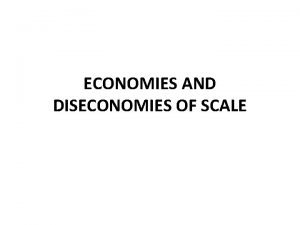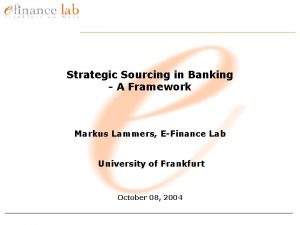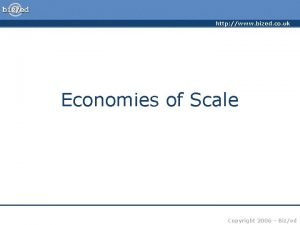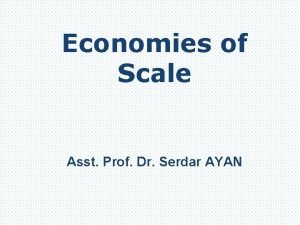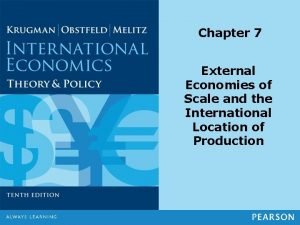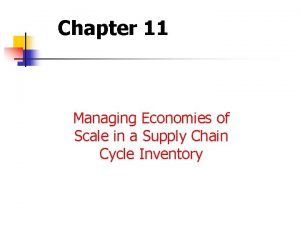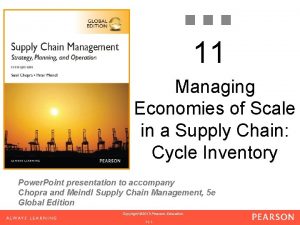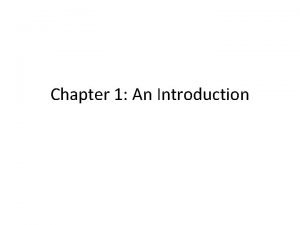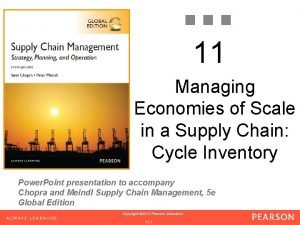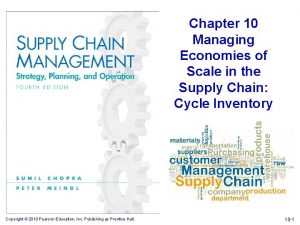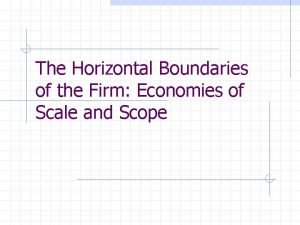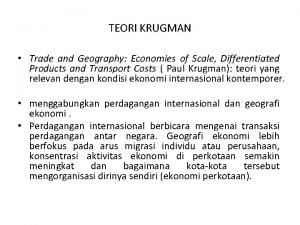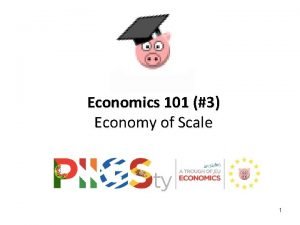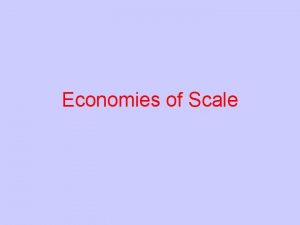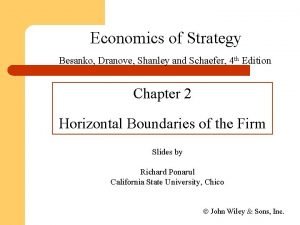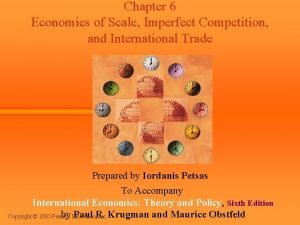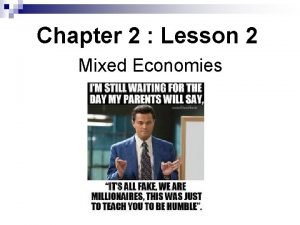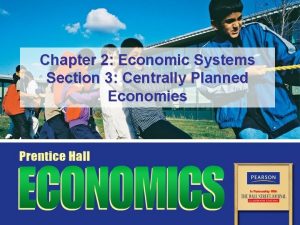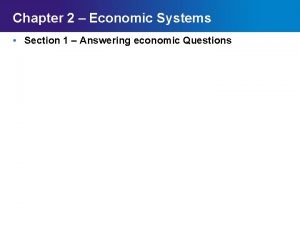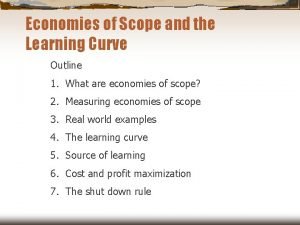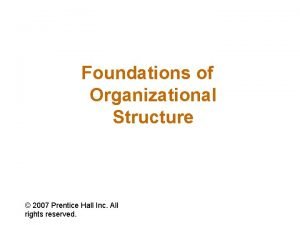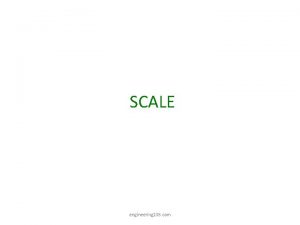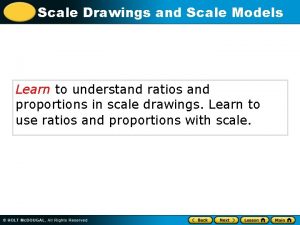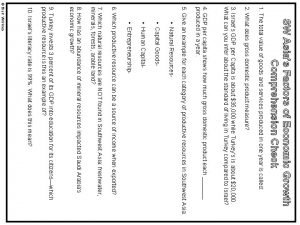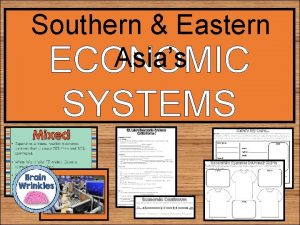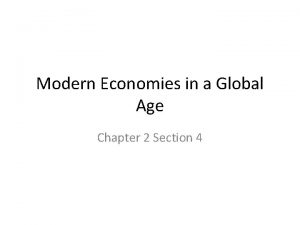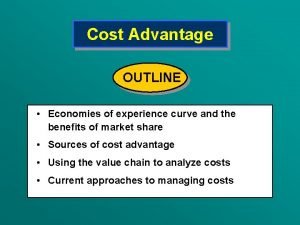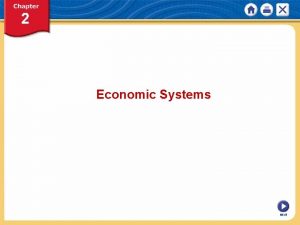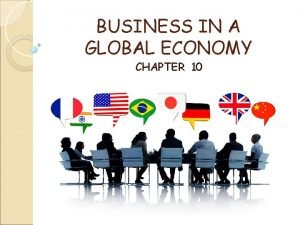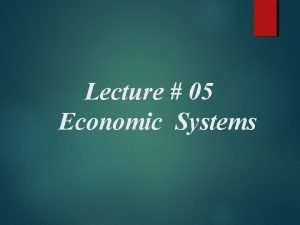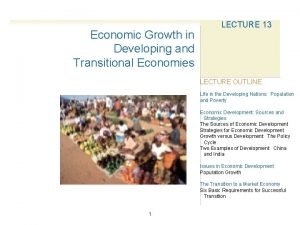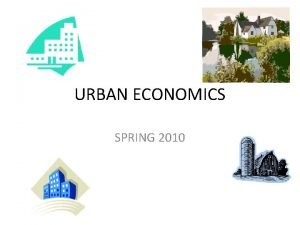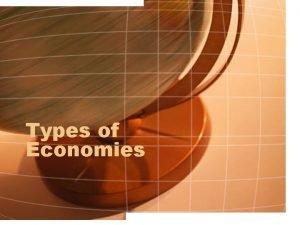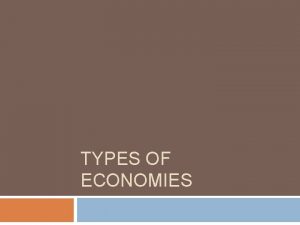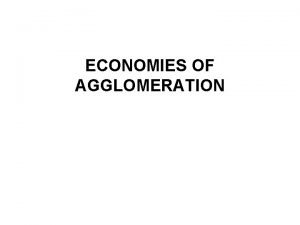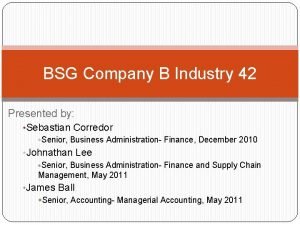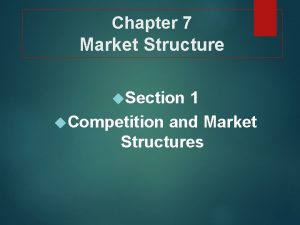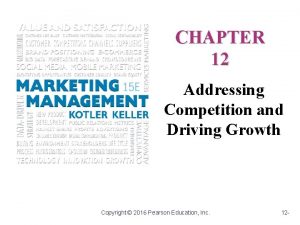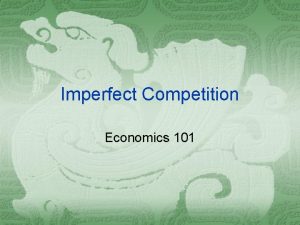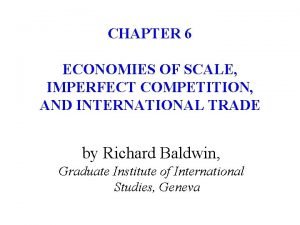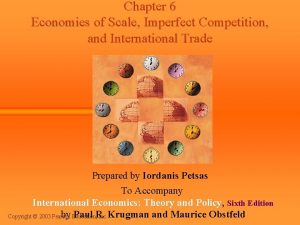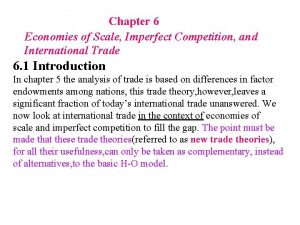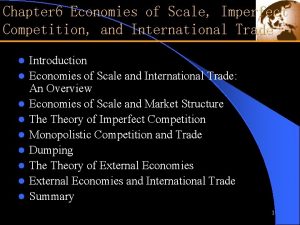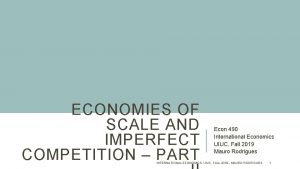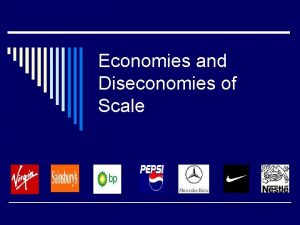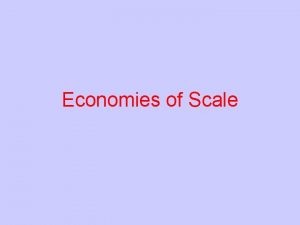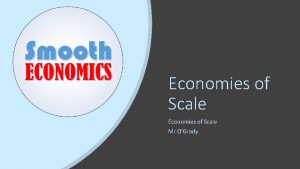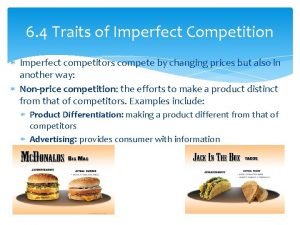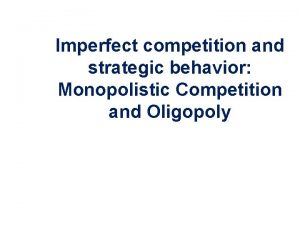Chapter 6 Economies of Scale Imperfect Competition and













![Monopolistic Competition (cont. ) Q = S[1/n – b(P – P)] ¨ Q is Monopolistic Competition (cont. ) Q = S[1/n – b(P – P)] ¨ Q is](https://slidetodoc.com/presentation_image_h2/77f86f344cf0f4aa2782f1bea8c51d94/image-14.jpg)




![Monopolistic Competition (cont. ) Q = S[1/n – b(P – P)] Q = S/n Monopolistic Competition (cont. ) Q = S[1/n – b(P – P)] Q = S/n](https://slidetodoc.com/presentation_image_h2/77f86f344cf0f4aa2782f1bea8c51d94/image-19.jpg)





































- Slides: 56

Chapter 6 Economies of Scale, Imperfect Competition, and International Trade 1

Preview • Types of economies of scale • Types of imperfect competition Oligopoly and monopoly ¨ Monopolistic competition ¨ • Monopolistic competition and trade • Inter-industry trade and intra-industry trade • Dumping • External economies of scale and trade 2

Introduction • When defining comparative advantage, the Ricardian model and the Heckscher-Ohlin model both assume constant returns to scale: ¨ If all factors of production are doubled then output will also double. • But a firm or industry may have increasing returns to scale or economies of scale: ¨ If all factors of production are doubled, then output will more than double. ¨ Larger is more efficient: the cost per unit of output falls as a firm or industry increases output. 3

Introduction (cont. ) • The Ricardian and Heckscher-Ohlin models also rely on competition to predict that all income from production is paid to owners of factors of production: no “excess” or monopoly profits exist. • But when economies of scale exist, large firms may be more efficient than small firms, and the industry may consist of a monopoly or a few large firms. ¨ Production may be imperfectly competitive in the sense that excess or monopoly profits are captured by large firms. 4

Types of Economies of Scale • Economies of scale could mean either that larger firms or that a larger industry (e. g. , one made of more firms) is more efficient. • External economies of scale occur when cost per unit of output depends on the size of the industry. • Internal economies of scale occur when the cost per unit of output depends on the size of a firm. 5

Types of Economies of Scale (cont. ) • External economies of scale may result if a larger industry allows for more efficient provision of services or equipment to firms in the industry. ¨ Many small firms that are competitive may comprise a large industry and benefit from services or equipment efficiently provided to the large group of firms. • Internal economies of scale result when large firms have a cost advantage over small firms, which leads to an imperfectly competitive market. 6

A Review of Monopoly • A monopoly is an industry with only one firm. • An oligopoly is an industry with only a few firms. • A characteristic of a monopoly (and to some degree an oligopoly) is that is marginal revenue generated from selling an additional unit of output is lower than the price of output. ¨ Without price discrimination, a monopoly must lower the price of an additional unit sold, as well as the prices of other units sold. ¨ The marginal revenue curve lies below the demand curve (which determines the price of units sold). 7

A Review of Monopoly (cont. ) 8

A Review of Monopoly (cont. ) • Average cost is the cost of production (C) divided by the total quantity of output produced (Q) at a time. ¨ AC = C/Q • Marginal cost is the cost of producing an additional unit of output. 9

A Review of Monopoly (cont. ) • Suppose that costs are measured by C = F + c. Q, ¨ where F represents fixed costs, independent of the level of output. ¨ c represents a constant marginal cost: the constant cost of producing an additional unit of output Q. • AC = F/Q + c • A larger firm is more efficient because average cost decreases as output Q increases: internal economies of scale. 10

A Review of Monopoly (cont. ) 11

Monopolistic Competition • Monopolistic competition is a model of an imperfectly competitive industry which assumes that 1. Each firm can differentiate its product from the product of competitors. 2. Each firm ignores the impact that changes in its own price will have on the prices competitors set: even though each firm faces competition it behaves as if it were a monopolist. 12

Monopolistic Competition (cont. ) • A firm in a monopolistically competitive industry is expected: ¨ to sell more the larger the total sales of the industry and the higher the prices charged by its rivals. ¨ to sell less the larger the number of firms in the industry and the higher its own price. • These concepts are represented by the mathematical relationship: 13
![Monopolistic Competition cont Q S1n bP P Q is Monopolistic Competition (cont. ) Q = S[1/n – b(P – P)] ¨ Q is](https://slidetodoc.com/presentation_image_h2/77f86f344cf0f4aa2782f1bea8c51d94/image-14.jpg)
Monopolistic Competition (cont. ) Q = S[1/n – b(P – P)] ¨ Q is an individual firm’s sales ¨ S is the total sales of the industry ¨ n is the number of firms in the industry ¨ b is a constant term representing the responsiveness of a firm’s sales to its price ¨ P is the price charged by the firm itself ¨ P is the average price charged by its competitors 14

Monopolistic Competition (cont. ) • To make the model easier to understand, we assume that all firms have identical demand functions and cost functions. ¨ Thus in equilibrium, all firms charge the same price: P = P • In equilibrium, ¨ Q = S/n + 0 ¨ AC = C/Q = F/Q + c = F(n/S) + c 15

Monopolistic Competition (cont. ) AC = F(n/S) + c • The larger the number of firms n in the industry, the higher the average cost for each firm because the less each firm produces. • The larger the total sales S of the industry, the lower the average cost for each firm because the more that each firm produces. 16

Monopolistic Competition (cont. ) 17

Monopolistic Competition (cont. ) • If monopolistic firms have linear demand curves, ¨ then the relationship between price and quantity may be represented as: Q = A – Bx. P ¨ where A and B are constants ¨ and marginal revenue may be represented as MR = P – Q/B • When firms maximize profits, they set marginal revenue = marginal cost: MR = P – Q/B = c 18
![Monopolistic Competition cont Q S1n bP P Q Sn Monopolistic Competition (cont. ) Q = S[1/n – b(P – P)] Q = S/n](https://slidetodoc.com/presentation_image_h2/77f86f344cf0f4aa2782f1bea8c51d94/image-19.jpg)
Monopolistic Competition (cont. ) Q = S[1/n – b(P – P)] Q = S/n – Sb(P – P) Q = S/n + Sb. P – Sb. P Q = A – Bx. P • Let A S/n + Sb. P and B ≡ Sb 19

Monopolistic Competition (cont. ) MR = P – Q/B = c MR = P – Q/Sb = c P = c + Q/Sb P = c + (S/n)/Sb P = c + 1/(nxb) • The larger the number of firms n in the industry, the lower the price each firm charges because of increased competition. 20

Monopolistic Competition (cont. ) • At some number of firms, the price that firms charge (which decreases in n) matches the average cost that firms pay (which increases in n). • This number of firms is the number at which each firm has zero profits: price matches average cost. • This number is the equilibrium number of firms. 21

Monopolistic Competition (cont. ) • If the number of firms is greater than or less than n 2, then in industry is not in equilibrium in the sense that firms have an incentive to exit or enter the industry. ¨ Firms have an incentive to enter the industry when profits are greater than zero (price > average cost). ¨ Firms have an incentive to exit the industry when profits are less than zero (price < average cost). 22

Monopolistic Competition and Trade • Because trade increases market size, trade is predicted to decrease average cost in an industry described by monopolistic competition. ¨ Industry sales increase with trade leading to decreased average costs: AC = F(n/S) + c • Because trade increases the variety of goods that consumers can buy under monopolistic competition, it increases the welfare of consumers. ¨ Because average costs decrease, consumers can also benefit from a decreased price. 23

Monopolistic Competition and Trade (cont. ) 24

Monopolistic Competition and Trade (cont. ) • As a result of trade, the number of firms in a new international industry is predicted to increase relative to each national market. ¨ But it is unclear if firms will locate in the domestic country or foreign countries. 25

Monopolistic Competition and Trade (cont. ) Hypothetical example of gains from trade in an industry with monopolistic competition Domestic market before trade Industry sales Number of firms Sales per firm Average cost Price Foreign Integrated market before market after trade 1, 600, 000 2, 500, 000 8 10 150, 000 200, 000 250, 000 10, 000 8, 750 8, 000 900, 000 6 26

Inter-industry Trade • According to the Heckscher-Ohlin model or Ricardian model, countries specialize in production. ¨ Trade occurs only between industries: inter-industry trade • In a Heckscher-Ohlin model suppose that: ¨ The capital abundant domestic economy specializes in the production of capital intensive cloth, which is imported by the foreign economy. ¨ The labor abundant foreign economy specializes in the production of labor intensive food, which is imported by the domestic economy. 27

Inter-industry Trade (cont. ) 28

Intra-industry Trade • Suppose now that the global cloth industry is described by the monopolistic competition model. • Because of product differentiation, suppose that each country produces different types of cloth. • Because of economies of scale, large markets are desirable: the foreign country exports some cloth and the domestic country exports some cloth. ¨ Trade occurs within the cloth industry: intra-industry trade 29

Intra-industry Trade (cont. ) • If domestic country is capital abundant, it still has a comparative advantage in cloth. ¨ It should therefore export more cloth than it imports. • Suppose that the trade in the food industry continues to be determined by comparative advantage. 30

Intra-industry Trade (cont. ) 31

Inter-industry and Intra-industry Trade 1. Gains from inter-industry trade reflect comparative advantage. 2. Gains from intra-industry trade reflect economies of scale (lower costs) and wider consumer choices. 3. The monopolistic competition model does not predict in which country firms locate, but a comparative advantage in producing the differentiated good will likely cause a country to export more of that good than it imports. 32

Inter-industry and Intra-industry Trade (cont. ) 4. The relative importance of intra-industry trade depend on how similar countries are. ¨ Countries with similar relative amounts of factors of production are predicted to have intra-industry trade. ¨ Countries with different relative amounts of factors of production are predicted to have inter-industry trade. 5. Unlike inter-industry trade in the Heckscher-Ohlin model, income distribution effects are not predicted to occur with intra-industry trade. 33

Inter-industry and Intra-industry Trade (cont. ) • About 25% of world trade is intra-industry trade according to standard industrial classifications. ¨ But some industries have more intra-industry trade than others: those industries requiring relatively large amounts of skilled labor, technology and physical capital exhibit intra-industry trade for the US. ¨ Countries with similar relative amounts of skilled labor, technology and physical capital engage in a large amount of intra-industry trade with the US. 34

Inter-industry and Intra-industry Trade (cont. ) Note: an index of 1 means that all trade is intra-industry trade. An index of 0 means that all trade is inter-industry trade. 35

Dumping • Dumping is the practice of charging a lower price for exported goods than for goods sold domestically. • Dumping is an example of price discrimination: the practice of charging different customers different prices. • Price discrimination and dumping may occur only if ¨ imperfect competition exists: firms are able to influence market prices. ¨ markets are segmented so that goods are not easily bought in one market and resold in another. 36

Dumping (cont. ) • Dumping may be a profit maximizing strategy because of differences in foreign and domestic markets. • One difference is that domestic firms usually have a larger share of the domestic market than they do of foreign markets. ¨ Because of less market dominance and more competition in foreign markets, foreign sales are usually more responsive to price changes than domestic sales. ¨ Domestic firms may be able to charge a high price in the domestic market but must charge a low price on exports if foreign consumers are more responsive to price changes. 37

Dumping (cont. ) • We draw a diagram of how dumping occurs when a firm is a monopolist in the domestic market but a small competitive firm in foreign markets. ¨ Because the firm is a monopolist in the domestic market, the domestic market demand curve is downward sloping, and the marginal revenue curve lies below that demand curve. ¨ Because the firm is a small competitive firm in foreign markets, the foreign market demand curve is horizontal, representing the fact that exports are very responsive to small price changes. 38

Dumping (cont. ) 39

Dumping (cont. ) • To maximize profits, the firm will sell a low amount in the domestic market at a high price PDOM , but sell in foreign markets at a low price PFOR. ¨ Since an additional unit can always be sold at PFOR , the firm will sell its products at a high price in the domestic market until marginal revenue there falls to PFOR. ¨ Thereafter, it will sell exports at PFOR until marginal costs exceed this price. • In this case, dumping is a profit-maximizing strategy. 40

Protectionism and Dumping • Dumping (as well as price discrimination in domestic markets) is widely regarded as unfair. • A US firm may appeal to the Commerce Department to investigate if dumping by foreign firms has injured the US firm. ¨ The Commerce Department may impose an “anti-dumping duty”, or tax, as a precaution against possible injury. ¨ This tax equals the difference between the actual and “fair” price of imports, where “fair” means “price the product is normally sold at in the manufacturer's domestic market ”. 41

Protectionism and Dumping (cont. ) • Next the International Trade Commission (ITC) determines if injury to the US firm has actually occurred or is likely to occur. • If the ITC determines that injury has occurred or is likely to occur, the anti-dumping duty remains in place. ¨ See http: //www. itds. treas. gov/ADD_CVD. htm 42

External Economies of Scale • If external economies exist, a country that has a large industry will have low costs of producing that industry’s good or service. • External economies may exist for a few reasons: 43

External Economies of Scale (cont. ) 1. Specialized equipment or services may be needed for the industry, but are only supplied by other firms if the industry is large and concentrated. ¨ For example, Silicon Valley in California has a large concentration silicon chip companies, which are serviced by companies that make special machines for manufacturing silicon chips. ¨ These machines are cheaper and more easily available for Silicon Valley firms than for firms elsewhere. 44

External Economies of Scale (cont. ) 2. Labor pooling: a large and concentrated industry may attract a pool of workers, reducing employee search and hiring costs for each firm. 3. Knowledge spillovers: workers from different firms may more easily share ideas that benefit each firm when a large and concentrated industry exists. 45

External Economies of Scale and Trade • If external economies exist, the pattern of trade may be due to historical accidents: ¨ countries that start out as large producers in certain industries tend to remain large producers even if some other country could potentially produce the goods more cheaply. 46

External Economies of Scale and Trade (cont. ) 47

External Economies of Scale and Trade (cont. ) • Trade based on external economies has an ambiguous effect on national welfare. ¨ There may be gains to the world economy by concentrating production of industries with external economies. ¨ But there is no guarantee that the right country will produce a good subject to external economies. ¨ It is even possible that a country is worse off with trade than it would have been without trade: a country may better off if it produces everything for its domestic market rather than pay for imports. 48

External Economies of Scale and Trade (cont. ) 49

External Economies of Scale and Trade (cont. ) • We have considered cases where external economies depend on the amount of current output at a point in time. • But external economies may also depend on the amount of cumulative output over time. • Dynamic external economies of scale (dynamic increasing returns to scale) exist if average costs fall as cumulative output over time rises. 50

External Economies of Scale and Trade (cont. ) • Dynamic increasing returns to scale could arise if the cost of production depends on the accumulation of knowledge and experience, which depend on the production process over time. • A graphical representation of dynamic increasing returns to scale is called a learning curve. 51

External Economies of Scale and Trade (cont. ) 52

External Economies of Scale and Trade (cont. ) • Like external economies of scale at a point in time, dynamic increasing returns to scale can lock in an initial advantage or head start in an industry. • Like external economies of scale at a point in time, dynamic increasing returns to scale can be used to justify protectionism. ¨ Temporary protection of industries enables them to gain experience: infant industry argument. ¨ But temporary is often for a long time, and it is hard to identify when external economies of scale really exist. 53

Summary 1. Economies of scale imply that more output at the firm or industry level causes average cost to fall. ¨ External economies of scale refer to the amount of output by an industry. ¨ Internal economies of scale refer to the amount of output by a firm. 2. With monopolistic competition, each firm has some monopoly power due to product differentiation but must compete with other firms whose prices are believed to be unaffected by each firm’s actions. 54

Summary (cont. ) 3. Monopolistic competition allows for gains from trade through lower costs and prices, as well as through wider consumer choice. 4. Monopolistic competition predicts intraindustry trade, and does not predict changes in income distribution within a country. 5. Location of firms under monopolistic competition is unpredictable, but countries with similar relative factors are predicted to engage in intra-industry trade. 55

Summary (cont. ) 6. Dumping may be a profitable strategy when a firm faces little competition in its domestic market and faces heavy competition in foreign markets. 7. Trade based on external economies of scale may increase or decrease national welfare, and countries may benefit from temporary protectionism if their industries exhibit external economies of scale either at a point in time or over time. 56
 Technical economies of scale
Technical economies of scale Economies of scope vs scale
Economies of scope vs scale Benefits of economies of scale
Benefits of economies of scale Risk bearing economies of scale
Risk bearing economies of scale Types of economies of scale
Types of economies of scale A key to reducing lot size without increasing costs is to
A key to reducing lot size without increasing costs is to Managing economies of scale in a supply chain
Managing economies of scale in a supply chain Economies of scale ap human geography
Economies of scale ap human geography Economic geography
Economic geography Managing economies of scale in a supply chain
Managing economies of scale in a supply chain Economies of scale
Economies of scale Horizontal boundaries of a firm
Horizontal boundaries of a firm Faktor penyebab economies of scale
Faktor penyebab economies of scale Economies of scale definition
Economies of scale definition Disadvantages of economies of scale
Disadvantages of economies of scale Cube square rule economies of scale
Cube square rule economies of scale Demand curve in oligopoly
Demand curve in oligopoly Imperfect competition
Imperfect competition The most extreme form of imperfect competition is
The most extreme form of imperfect competition is Unit 4 imperfect competition
Unit 4 imperfect competition Types of imperfect competition
Types of imperfect competition Characteristics of a monopoly
Characteristics of a monopoly Perfect competition vs monopolistic competition
Perfect competition vs monopolistic competition Market structure venn diagram
Market structure venn diagram Competition refers to
Competition refers to Chapter 2 lesson 2 mixed economies
Chapter 2 lesson 2 mixed economies Centrally planned economy
Centrally planned economy Centrally planned economy
Centrally planned economy Economics chapter 2 section 3 assessment answers
Economics chapter 2 section 3 assessment answers Chapter 7 section 1 regional economies create differences
Chapter 7 section 1 regional economies create differences Learning curve economies
Learning curve economies Explain economies and diseconomies of work specialization
Explain economies and diseconomies of work specialization Scale up and scale out in hadoop
Scale up and scale out in hadoop Plain scale can measure upto
Plain scale can measure upto Scale up scale down
Scale up scale down Inner scale outer scale protractor
Inner scale outer scale protractor A proportional, two-dimensional drawing of an object.
A proportional, two-dimensional drawing of an object. Adjustable cross staff in surveying
Adjustable cross staff in surveying Sw asian economies comprehension check answer key
Sw asian economies comprehension check answer key Se asia's governments comprehension check
Se asia's governments comprehension check Section 4 modern economies
Section 4 modern economies Experience curve benefits
Experience curve benefits Mixed economies in a sentence
Mixed economies in a sentence Chapter 10 business in a global economy
Chapter 10 business in a global economy Sw asia economies cloze notes 1
Sw asia economies cloze notes 1 Characteristics of mixed economy
Characteristics of mixed economy Five fundamental questions of the market system
Five fundamental questions of the market system Transition economies
Transition economies Transition economies
Transition economies Agglomeration economies
Agglomeration economies Traditional economy meaning
Traditional economy meaning 3 main questions of economics
3 main questions of economics Traditional economy
Traditional economy Agglomeration economies
Agglomeration economies Bsg footwear industry report
Bsg footwear industry report Lesson quiz 7-1 market structures
Lesson quiz 7-1 market structures Copyright
Copyright
